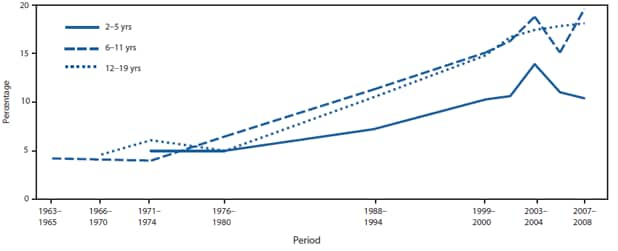"In the United States, childhood obesity affects approximately 12.5 million children and teens (17% of that population). Changes in obesity prevalence from the 1960s show a rapid increase in the 1980s and 1990s, when obesity prevalence among children and teens tripled, from nearly 5% to approximately 15%. During the past 10 years, the rapid increase in obesity has slowed and might have leveled. However, among the heaviest boys, a significant increase in obesity has been observed, with the heaviest getting even heavier. Moreover, substantial racial/ethnic disparities exist, with Hispanic boys and non-Hispanic black girls disproportionately affected by obesity. Also, older children and teens are more likely to be obese compared with preschoolers.
In the short term, obesity in children can lead to psychosocial problems and to cardiovascular risk factors such as hypertension, high cholesterol, and abnormal glucose tolerance or diabetes. In one study, 70% of obese children had at least one additional cardiovascular risk factor, and 30% had two or more. Although the prevalence of type 2 diabetes in teens is very low, a recent report estimated that 15% of new diabetes cases among children and adolescents are type 2 diabetes. In the 1980s, type 2 diabetes in teens was virtually unheard of.
The prevalence of obesity among U.S. adults (34%) is twice that observed in children and translates into nearly 73 million adult men and women. On average, U.S. adults weigh 24 pounds more than they did in 1960, and they are at increased risk for health conditions such as diabetes, cardiovascular disease, and certain cancers. Although obesity prevalence has remained mostly flat in the past 10 years, the costs associated with obesity have increased substantially during the same period. One study estimated that approximately 9% of all medical costs in 2008 were obesity-related and amounted to $147 billion, compared with $78.5 billion 10 years before".
The report continues to discuss interventions that have taken place and make suggestions for other pro-active steps. It also shares some visuals to bring the message home:

You are encouraged to read the full report to understand the push from all angles to get kids healthier and fitter. It is of strategic and national interest.
Michael Cordier
No comments:
Post a Comment